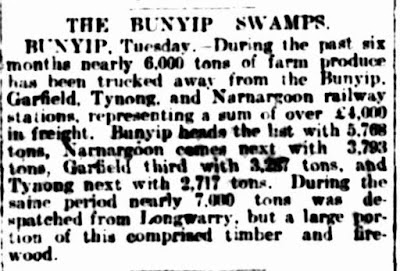The
South Bourke and Mornington Journal
reported on a divorce case on February 15. There were no privacy considerations
in those days and divorces were often reported in full detail. In this case, the
divorce was reported in two local papers and the Melbourne dailies, The Age and The Argus. George Bird sought
a divorce from his wife, Grace Bird, on the ground of desertion. Both the
parties were 52 years of age and they had been married in October 1896 and there
were two children. In January 1909, Grace had left Garfield, where they had
been living for eight years taking her daughter with her. George had seen her
twice since then and she stated that she would not return because she found
life in the country, ‘too slow’. The divorce was granted and the alimony was
fixed at the rate of 15 shillings a week. George was a baker and it was
reported in a paper in August that he was building a new brick bakehouse and
storeroom in Garfield.
On March 1, the Dandenong Advertiser reported on the annual excursion of children attending schools from Longwarry
to Pakenham took place. The trip was to Sandringham, one of the beautiful stretches of our bay shore. A very
large number of children accompanied by their parents and friends were conveyed
to the seaside in three special trains which were fully loaded. The trip being
thoroughly enjoyed by the excursionists.
There was a report in The Argus of March 22, of two house fires in Garfield. On March 15, Mr T.W. Jefferson’s four roomed
house was totally destroyed by fire caused by the wind blowing open the front
door and scattering sparks from the fire. On March 19, a house owned by Mr H.A.
Hourigan and occupied by Mr & Mrs Norton was set alight when Mrs Norton
accidently overturned a lamp. The blaze spread quickly and the house was well
alight before help was available. The report goes on to say that the house was
insured for £130 and the furniture for £100.
T. W Jefferson was Thomas William Jefferson, the brick maker and H. A
Hourigan was Henry Hourigan who was a coach builder.
In
May, it was widely reported in many papers that Carlo Catani had retired as Chief Engineer of
the Public Works Department. A function was held on May 9 and the Premier of
Victoria, Sir Alexander Peacock presented Mr Catani with an ‘Illuminated
address’. Catani was responsible for the all drainage works on the Koo Wee Rup
Swamp from 1893 and had been employed by various Government Departments since
his arrival in Melbourne from Italy (via New Zealand) in 1876.
The
Cora Lynn Horticultural Show was held on May 12. The exhibits were down from previous years but they were of very good
quality, in fact the fancy work was of an exceptionally fine standard a triumph
of art and patient industry. (Dandenong Advertiser, May 24, 1917). Whilst on the subject of shows, the Iona
Cheese Factory won a prize at the Royal Melbourne Show in September for the best
cheese over 6 months old and not less than 300lbs in weight (that’s 136kg - a big
cheese!) The Cora Lynn Cheese factory was second. (The Age, September 26, 1917)
Gippsland Independent June 22, 1917
On
June 8, local teachers met at Tynong and were given instruction in gardening. The
instructor, Mr Lee, of the Drouin School pointed
out that the geometrical style was not now encouraged, and that elaborate and
complicated arrangement of flower beds should be avoided. He advised having
most of the school garden laid out in grass, and flower beds distributed over
those lawns. Shrubs formed a fine background for the beds. Teachers today, should be grateful that they
don’t have to plant and maintain the school gardens in addition to their many
other duties! (Gippsland Independent, June 22, 1917)
In more school news on September 13, the Dandenong Advertiser reported that September, Garfield Head Teacher, Mr Thomas Loutit was transferred to Sea Lake and in December various newspapers reported that Mr William Waugh was transferred to Garfield State School from Elphinstone.
In more school news on September 13, the Dandenong Advertiser reported that September, Garfield Head Teacher, Mr Thomas Loutit was transferred to Sea Lake and in December various newspapers reported that Mr William Waugh was transferred to Garfield State School from Elphinstone.
At
the beginning of August, Mrs Aspinall, the wife of the Manager of the London
Bank in Garfield was presented with a
very chaste silver rose bowl, suitably inscribed by the members of the
Church of England Sunday school. Chaste
in this case means without unnecessary ornament. Mr Aspinall was presented with
a gift, a valuable case of pipes at a
social evening a few weeks later. William and Jean Aspinall were moving to
Moama, they had been in Garfield since about 1913. (Dandenong Advertiser, August 9, 1917 and August 30, 1917)
Dandenong Advertiser August 9 1917
The
Pakenham Gazette of September, 14 reported that the Post Office, known as Kirwan’s was to be changed to Vervale. This is
the Post Office on the corner of Main Drain Road and the Thirteen Mile. It was
known as Kirwan’s after John Kirwan who ran the Post
Office and general store from 1907 until 1915 when it was taken away from him
as he was convicted of selling liquor without a license.
And finally in November in a report on the
Berwick Shire Council meeting, Cr Pearson pointed out that owing to the different meal hours at various Post Offices the
telephone service was held up from about 4 p.m. to 6 p.m. every day. At Nar Nar
Goon, the office was closed from about 4pm to 5pm and at Bunyip from
5pm to 6pm. He moved that the Department be asked to arrange for a uniform
closing hour. The motion was seconded by Cr Dore and carried. (Pakenham Gazette, November 9 1917)








